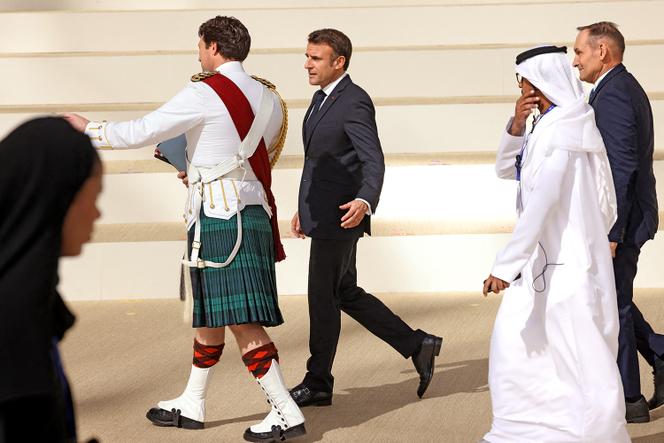


Where was he heading to? A conference on the art of "decarbonizing without upsetting investors"? Or perhaps to a round table on "the economic prospects of converting oil into an energy drink"? Neither. On Friday, December 1, French President Emmanuel Macron was off to a photo shoot designed to immortalize the great moment of communion, solidarity and, above all, hope that is COP28. In Dubai, the world's leaders are gathered to fight global warming and offer us an enchanted future. Hooray!
For a quick walk (after all, isn't there a climate emergency?), the head of state wore a pair of black leather shoes with two metal buckles. Invented by the venerable English firm John Lobb nearly 80 years ago, this model bears the name "double monk." Why such a name? Simply because monks were historically fond of buckled shoes.
To get to the photo shoot, the French president was supported by a dashing guide, who was also strikingly shod. On his black boots rested what the English call spats. The height of masculine elegance in the 1920s, spats were originally designed to protect boots from mud and rain, but over time they became an object of virilistic one-upmanship. The most elegant and wealthy men prided themselves on wearing immaculate white spats at all times, and scorned those whose spats were soiled.
The interesting outfit didn't end with the spats. This member of the Canadian delegation had donned his mess dress uniform, the most formal of military garb. He's wearing a white Spencer jacket, a red scarf and, best of all, a kilt. Why is the Canadian in a kilt, you may ask? It's because 16 regiments of the Canadian army have maintained the dress code of the Scottish army into the present day, as a reminder of the historical ties binding the two countries. In the 18th century, many Scots migrated to Canada.
Given that you don't have (clothing-induced) travel sickness, let's finally take a look at the man on the right of the photograph, and more specifically at the ribbon around his head. What is it? It's an agal, of course. Originally intended for tying camels' legs together to prevent them from escaping at night, this thick black rope tightened around a core of goat's wool enables men from the Arabian Peninsula to keep their shemagh (or keffiyeh) headwear in place, while also offering them, incidentally, the ideal carrier for a delicate hint of perfume.
Translation of an original article published in French on lemonde.fr; the publisher may only be liable for the French version.
